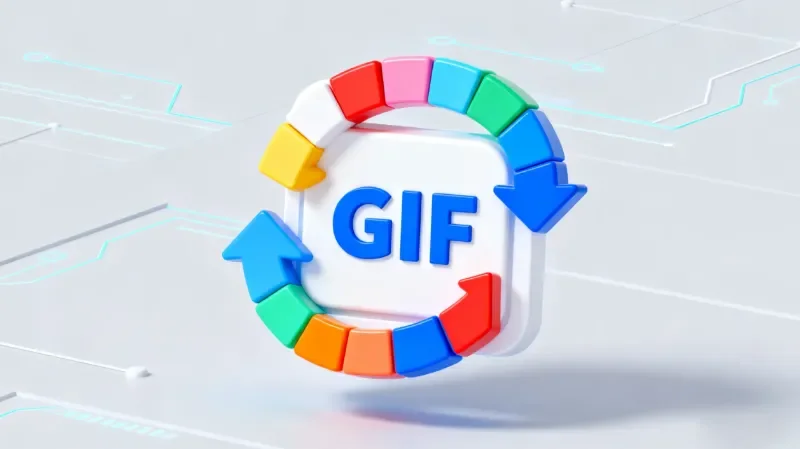Understanding GIF: What is a GIF and How It Works
convert video to gif
Introduction
The Graphics Interchange Format (GIF for short) is a bitmap-based image file format. It was first introduced by CompuServe in 1987.
Its core features include support for a 256-color indexed palette, a lossless LZW compression algorithm, and dynamic frame sequence functionality.
This format achieves data compression by mapping pixel colors to a predefined palette, resulting in file sizes that are generally smaller than those of uncompressed BMP files while preserving the clarity of the original image.
Its dynamic nature stems from the serialized storage of multiple frames with time intervals, creating an animation effect through continuous looping playback.
This characteristic made it the mainstream medium for spreading dynamic content in the early days of the Internet.
Version Evolution
The GIF format has undergone three key iterations:
· GIF 87a (1987): This version laid the foundational framework, establishing the file header identifier, logical screen description block, and global color palette structure. However, it did not support transparency or animation features.
· GIF 89a (1989): This iteration introduced a transparency channel, frame delay control, and loop count settings. A new Graphic Control Extension was added to define the display duration of each frame, laying the groundwork for modern GIF animation technology.
· Patent Dispute and Revival (1994 - 2010): The LZW algorithm's patent ownership sparked industry controversy. However, with the popularity of alternative formats like PNG and the expiration of the patent, GIF experienced a revival in 2010, riding the wave of social media. After various platforms introduced auto-play functionality, its dissemination efficiency and usage scenarios expanded significantly.
File Structure Analysis
GIF files adopt a modular data stream architecture, with core components including:
· Header: A fixed 6-byte section containing the "GIF" identifier and version number.
· Logical Screen Descriptor: Defines the canvas size, a flag indicating the presence of a global color palette, and the background color index.
· Global Color Table: An optional data block that stores up to 256 colors, shared by all subsequent image frames.
· Graphic Control Extension: Controls the transparency, delay time, and loop count of a single frame.
· Image Descriptor: Locates the frame position and can be associated with a Local Color Table to override the global color palette.
· Image Data: A sequence of pixel indices compressed using the LZW algorithm, reducing redundant data through dictionary encoding.
· Trailer: A single-byte "0x3B" marking the end of the file.
Dynamic GIFs achieve multi-frame animation by alternately storing image descriptors and compressed data. Each frame can be independently configured with a display duration, and the player renders them in a time-sequenced loop.
Technical Characteristics
· Color Limitation and Optimization: A single frame can use up to 256 colors, but the global and local color palettes can be dynamically switched to balance file size and color performance.
· Lossless Compression Efficiency: The LZW algorithm eliminates redundant data by constructing a dynamic dictionary, typically achieving a compression rate of 30% - 70% of the original BMP file. It is particularly suitable for images with large areas of solid colors or repeating patterns.
· Transparency Channel Support: The 89a version introduced a transparency index mechanism, enabling the overlay display of non-rectangular images by designating a color in the palette as transparent.
· Cross-Platform Compatibility: Due to its color depth being compatible with early computer hardware and not requiring complex decoders, it achieves a "click-to-play" effect on web pages and instant messaging tools.
Application Scenarios
· Digital Entertainment: As the core medium for online emoticons, GIFs enhance emotional expression through exaggerated dynamic effects, such as the classic "split" and "speechless" emoticons on social platforms.
· Information Visualization: In the educational field, GIFs break down complex processes (such as chemical reactions and mechanical movements) to improve knowledge transfer efficiency. In commercial advertising, they enhance visual appeal by continuously playing product details.
· Technical Verification: During the development phase, GIF recording software is often used to capture software operation processes, facilitating cross-team collaboration and problem reproduction.
· Artistic Creation: Digital artists utilize its frame sequence characteristics to create pixel animations, continuing its aesthetic value in retro game development and dynamic poster design.
Conclusion
After more than three decades of development, GIF has evolved from a technical document medium into a digital cultural symbol, thanks to its lightweight nature, high compatibility, and dynamic expression capabilities.
Despite facing competition from new formats like APNG and WebP, its unique value in social interaction, educational outreach, and other fields remains irreplaceable.
In the future, with improvements in hardware performance and optimization of compression algorithms, GIF is expected to expand into more diverse application scenarios while maintaining its low-barrier advantages.
References
"Graphics Interchange Format, Version 87a" W3C. 15 June 1987.
"Graphics Interchange Format, Version 89a" W3C. 31 July 1990.
"Online Art" Compute!'s Apple Applications. December 1987. p. 10. Retrieved 14 September 2016.
"The GIF Is on Its Deathbed" Tiffany, Kaitlyn (7 October 2022).